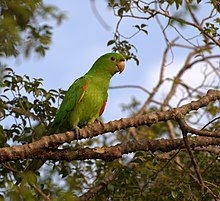White-eyed parakeet
| White-eyed parakeet | |
|---|---|

| |
| In Piraju, Brazil | |
| Psittacara leucophthalmus - White-eyed Parakeet | |
| Scientific classification | |
| Domain: | Eukaryota |
| Kingdom: | Animalia |
| Phylum: | Chordata |
| Class: | Aves |
| Order: | Psittaciformes |
| Family: | Psittacidae |
| Genus: | Psittacara |
| Species: | P. leucophthalmus
|
| Binomial name | |
| Psittacara leucophthalmus (Müller, PLS, 1776)
| |

| |
| Synonyms[3] | |
| |
The white-eyed parakeet (Psittacara leucophthalmus), known in
Taxonomy and systematics
The white-eyed parakeet was for a time placed in the genus Aratinga but from about 2013 has been in its present genus Psittacara.[7] It has these three subspecies:[5]
- P. l. callogenys (Salvadori, 1891)
- P. l. leucophthalmus (Müller, P.L.S., 1776)
- P. l. nicefori (Meyer de Schauensee, 1946)
What is now
The white-eyed parakeet's

Description
The white-eyed parakeet is 32 to 35 cm (13 to 14 in) long with a 37 to 40 cm (15 to 16 in)[
Distribution and habitat
The nominate subspecies of the white-eyed parakeet has the widest distribution. It is found on Trindad
The white-eyed parakeet inhabits a wide variety of landscapes, most of which are somewhat open. These include the edges of dense forests and nearby savannahs, secondary forests, gallery forests, várzea forests (especially in Ecuador), palm groves, mangroves, and clearings in rainforests. It is generally a bird of the lowlands, reaching 700 m (2,300 ft) in Colombia and 1,100 m (3,600 ft) in Ecuador but occurring as high as 2,500 m (8,200 ft) in Bolivia.[10][11][12][14]
Behavior
The white-eyed parakeet congregates in flocks that may number several hundred birds and include other parrot species. It roosts communally in trees and also in cane fields and caves.[10][4]
Movement
The white-eyed parakeet is non-migratory but apparently roams in response to food availability.[10]
Feeding
The white-eyed parakeet's diet is mostly fruit but also includes seeds, flowers, and small numbers of
Breeding
The white-eyed parakeet's breeding season varies widely across its very large range. It nests in cavities in trees and palms. The clutch size is three to four eggs. In captivity, the incubation period is four weeks and fledging occurs nine weeks after hatch.[10]
Vocalization
The white-eyed parakeet is very vocal, especially in flight with "a grating chattering interspersed with higher-pitched shrieks"[10] described as "r'teet-r'teet-tiw-"[11]. It also makes "[s]harp squeaky notes and loud harsh calls" described as "scree-ah".[10]
Status
The
Aviculture
Though not as popular as some of the more colorful parakeets, the white-eyed parakeet can become a sweet, loving and talkative pet.[15] They are seldom destructive and are generally not screamers, often choosing to mimic speech instead. Although many breeders ignore this species, those that do breed them appreciate their good parenting skills. Breeding requirements for white-eyed parakeets are much the same as for other parakeet species.
They will usually start to nest in March or April, sometimes breeding throughout the year and having four to six clutches.[dubious ] The clutch size is usually four eggs. Chicks will sometimes start to talk by the time they are weaned and generally will talk by six months of age.
White-eyed parakeets are sometimes confused with Finsch's parakeets because both have red and yellow epaulets under their wings. The white-eyed parakeets lack the red triangle on the forehead as adults. In captivity, they can live for 25–30 years.[4]
References
- ^ . Retrieved 8 April 2023.
- ^ "Appendices | CITES". cites.org. Retrieved 8 April 2023.
- ^ Remsen, J. V., Jr., J. I. Areta, E. Bonaccorso, S. Claramunt, A. Jaramillo, D. F. Lane, J. F. Pacheco, M. B. Robbins, F. G. Stiles, and K. J. Zimmer. Version 30 January 2023. A classification of the bird species of South America. American Ornithological Society. https://www.museum.lsu.edu/~Remsen/SACCBaseline.htm retrieved 30 January 2023
- ^ a b c "WHITE-EYED CONURE (Psittacara leucophthalmus)". World Parrot Trust. Retrieved 8 April 2023.
- ^ a b Gill, F.; Donsker, D.; Rasmussen, P., eds. (January 2023). "Parrots, cockatoos". IOC World Bird List. v 13.1. Retrieved 18 February 2023.
- ^ Remsen, J. V., Jr., J. I. Areta, E. Bonaccorso, S. Claramunt, A. Jaramillo, D. F. Lane, J. F. Pacheco, M. B. Robbins, F. G. Stiles, and K. J. Zimmer. 30 January 2023. Species Lists of Birds for South American Countries and Territories. https://www.museum.lsu.edu/~Remsen/SACCCountryLists.htm retrieved 30 January 2023
- ^ Remsen, James V.; Urantówka, Adam (2013). "Divide Aratinga into four genera". AOS South American Classification Committee. Retrieved 5 April 2023.
- ^ Collar, N., P. F. D. Boesman, and C. J. Sharpe (2020). Crimson-fronted Parakeet (Psittacara finschi), version 1.0. In Birds of the World (J. del Hoyo, A. Elliott, J. Sargatal, D. A. Christie, and E. de Juana, Editors). Cornell Lab of Ornithology, Ithaca, NY, USA. https://doi.org/10.2173/bow.crfpar.01 retrieved 8 April 2023
- ISBN 0-19-910207-4.
- ^ a b c d e f g h i j Collar, N., P. F. D. Boesman, and C. J. Sharpe (2020). White-eyed Parakeet (Psittacara leucophthalmus), version 1.0. In Birds of the World (J. del Hoyo, A. Elliott, J. Sargatal, D. A. Christie, and E. de Juana, Editors). Cornell Lab of Ornithology, Ithaca, NY, USA. https://doi.org/10.2173/bow.whepar2.01 retrieved 8 April 2023
- ^ ISBN 978-0-19-530155-7.
- ^ ISBN 978-0-8014-8721-7.
- ^ Kenefick, Martyn (22 September 2020). "Species lists of birds for South American countries and territories: Trinidad and Tobago". South American Classification Committee of the American Ornithological Society. Retrieved 8 April 2023.
- ^ ISBN 978-0-9827615-0-2.
- ^ Kalhagen, Alyson. "White-Eyed Conure (Parakeet): Bird Species Profile". The Spruce Pets. Retrieved 6 July 2021.
External links
- Stamps[usurped] (for French Guiana, Paraguay) with ~RangeMap


